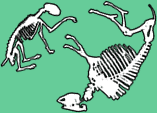|
It was shocking stuff. The implications were
enormous. It showed us just how the world is interconnected.
We had little idea of possible consequences of these new combinations
of substances. Now, much of science is concerned with these
new interactions and new combinations.
From being the wonder chemical, DDT came to be recognised
as possessing hazards for which we had no name.

|
|
More about DDT |
 |
Industry did not like
the new attacks. The new concerns were beyond their usual domain, and threatened
their livelihood. The chemical industry mounted campaigns to minimise or ridicule
the claims. But the evidence continued to mount. And the science called ecology
developed to supply the answers.
In the mid 1960s, another group of chlorinated chemicals - called PCBs, were found
in virtually all living tissue. There was even greater concern as these chemicals
had not been sprayed all over the countryside. They were used only in electrical
products. The only way they could have become so widespread was from waste disposal.
Ten years from the first findings in 1966 the substances were banned. |

